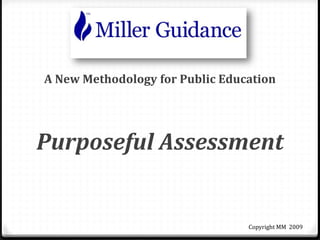
Purposeful assessments
- 1. A New Methodology for Public Education Purposeful Assessment Copyright MM 2009
- 2. Do you want to organize your assessments but you don’t know how?
- 3. Assessments are chosen to fulfill a need; to answer a question. Needed by whom, you ask?
- 4. Information is needed for decision making by: 0 Parents 0 Teachers 0 Grade level teams 0 Principals 0 District administration 0 State education officials and 0 the US Department of Education
- 5. It is a fine line Your assessment plan needs to be efficient! Data is needed to insure that all students receive appropriate instruction throughout their education However, too much assessment takes away from instructional minutes and can negatively impact student growth
- 6. Tests are organized according to purpose. So, use tests that serve multiple purposes.
- 7. What tests can be used for more than one purpose, you ask? Let’s start by describing the purposes that assessments serve.
- 8. Classroom assessments – formative and summative – mastery measurement Are the students learning the material I am currently teaching and what changes can I make to increase their learning? How much of what was taught in the lesson/unit/course did the students learn? Universal Screening and Progress Monitoring General Outcome Measurement As a result of the program my students are receiving, do the indicators suggest that they are on the path to becoming college and career ready? What changes can I make in my program to improve student performance? Program evaluation High Stakes Tests - summative Have my students met the state criteria for proficiency? Diagnostic Assessment for some students Why is this student(s) failing to make progress in this program? Assessments in Education Miller Guidance, Inc.
- 9. The Assessment Hierarchy • There are two sections Assessments given to: • all students • students who are at risk • Assessment Hierarchies are constructed for grade levels and skill areas. They are clustered according to the curriculum that they represent. For example, if a district uses a reading curriculum for K- 6 and a language arts curriculum for 7- 8, the Assessment Hierarchies would mirror this configuration. However, if grades 6-8 use a language arts curriculum, then the reading Hierarchies would cluster K-5 and 6-8. • Students who are at risk are defined by the universal screening tool. (Below the 25th percentile using a standards based cut score)
- 10. The Assessment Hierarchy • Some diagnostic tests are given to all students; students who are at risk are given additional diagnostics, if needed • The rigor of diagnostic testing matches the severity of need. So students scoring below the 10th percentile are given a more rigorous battery of diagnostics than students between the 10th and the 25th percentiles • If the teacher or interventionist knows what instructional focus the student needs, there is no reason to administer diagnostics • Progress monitoring is conducted with all students receiving supplemental support • The frequency with which progress monitoring data is collected is relative to the severity of need
- 11. Some Underlying Premises: • Universal screening identifies students at risk; does not analyze why • Program supports are designed for students scoring at risk on the universal screener • The specific supplemental supports that these students receive is determined by diagnostic assessments. Common formative and formative assessments are diagnostic but generally are more closely aligned to the student’s curriculum • Different screeners exist for different target skills. Align your screening tool to the skills that are important for that age or grade • Universal screeners are brief and reliable indicators of a larger body of skills. They don’t test everything but they do test important things
- 12. Some Underlying Premises (Continued): • Diagnostic assessments take longer to administer and score. Because they tell us what a student needs, they are constructed to have many production-type items • Diagnostic tests can also be summative. They are used for program eligibility and evaluation purposes • Program evaluation tools use standards based criteria and are in essence “progress monitoring” for the entire population • Individual progress monitoring tools align to the universal screener since the universal screener is the tool that determined risk. Local norms are often used as a criterion on these measures • All students are given some diagnostic tests but school resources can be conserved if additional diagnostic tests are only given to students who are at risk and for whom the teachers need information on instructional focus
- 13. A Basic Reading Skills Example Grades 1-5 -State Test -R-CBM -Reading series theme tests -Reading Curriculum Based Measurement (R-CBM) -Reading series theme tests -Curriculum based evaluation -Intervention assessment -Curriculum based evaluation -Intervention assessment -Diag Reading Assess 2 (DRA-2) -Texas Primary Reading Inventory -Reading Curriculum Based Measurement (R-CBM) -Reading Curriculum Based Measurement (R-CBM)
- 14. A College and Career Ready Example High School -State Test -Early Warning System (EWS) -EPAS/Work Keys -Early Warning System (EWS) -EPAS -Work Keys -Review records -Interview parents, teachers, student -Observe student -EWS -Intervention measurement plan -Review records -Interview parents, teachers, student -Observe student -Test basic skills -EWS -Intervention measurement plan
- 15. The Steps to an Aligned Assessment Plan. 1. Inventory the assessments used by staff. Include ELL and special education assessments. Also, ask general education teachers to list the tools that they use to gauge student learning, no matter how informal. 2. Compile a list and note which assessments are required by the district or state. 3. Classify each assessment according to purpose (Universal screening, Diagnostic, Progress monitoring, Program evaluation)
- 16. The Steps to an Aligned Assessment Plan. 4. Decide which Assessment Hierarchies you will use (K-5 Reading, K-5 Math, 6-8 Reading etc.) 5. Place the assessments that you are currently using on the appropriate Hierarchy 6. Note where there are gaps and overlaps 7. Formulate a plan for eliminating overlapping assessments and acquiring assessments to fill in gaps
- 17. For more practical resources visit www.millerguidance.com
